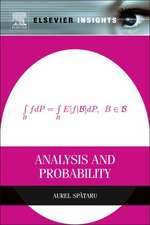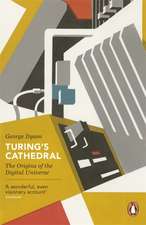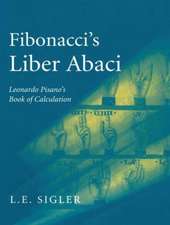Fatou, Julia, Montel: The Great Prize of Mathematical Sciences of 1918, and Beyond: Lecture Notes in Mathematics, cartea 2014
Autor Michèle Audinen Limba Engleză Paperback – 30 ian 2011
Din seria Lecture Notes in Mathematics
- 17%
 Preț: 360.42 lei
Preț: 360.42 lei -
 Preț: 459.92 lei
Preț: 459.92 lei -
 Preț: 121.41 lei
Preț: 121.41 lei -
 Preț: 175.68 lei
Preț: 175.68 lei -
 Preț: 197.00 lei
Preț: 197.00 lei -
 Preț: 279.76 lei
Preț: 279.76 lei -
 Preț: 477.65 lei
Preț: 477.65 lei - 17%
 Preț: 361.88 lei
Preț: 361.88 lei -
 Preț: 252.37 lei
Preț: 252.37 lei -
 Preț: 353.99 lei
Preț: 353.99 lei -
 Preț: 138.88 lei
Preț: 138.88 lei -
 Preț: 152.61 lei
Preț: 152.61 lei -
 Preț: 116.67 lei
Preț: 116.67 lei -
 Preț: 102.77 lei
Preț: 102.77 lei - 17%
 Preț: 365.52 lei
Preț: 365.52 lei -
 Preț: 396.75 lei
Preț: 396.75 lei - 17%
 Preț: 362.12 lei
Preț: 362.12 lei -
 Preț: 396.11 lei
Preț: 396.11 lei -
 Preț: 357.78 lei
Preț: 357.78 lei - 17%
 Preț: 362.31 lei
Preț: 362.31 lei -
 Preț: 403.80 lei
Preț: 403.80 lei - 17%
 Preț: 361.70 lei
Preț: 361.70 lei -
 Preț: 499.87 lei
Preț: 499.87 lei -
 Preț: 457.03 lei
Preț: 457.03 lei -
 Preț: 395.90 lei
Preț: 395.90 lei -
 Preț: 459.00 lei
Preț: 459.00 lei -
 Preț: 487.57 lei
Preț: 487.57 lei -
 Preț: 424.01 lei
Preț: 424.01 lei -
 Preț: 487.57 lei
Preț: 487.57 lei -
 Preț: 330.55 lei
Preț: 330.55 lei -
 Preț: 325.75 lei
Preț: 325.75 lei -
 Preț: 350.30 lei
Preț: 350.30 lei -
 Preț: 331.31 lei
Preț: 331.31 lei -
 Preț: 408.37 lei
Preț: 408.37 lei -
 Preț: 328.25 lei
Preț: 328.25 lei -
 Preț: 421.28 lei
Preț: 421.28 lei -
 Preț: 276.08 lei
Preț: 276.08 lei -
 Preț: 424.60 lei
Preț: 424.60 lei -
 Preț: 422.05 lei
Preț: 422.05 lei -
 Preț: 505.01 lei
Preț: 505.01 lei -
 Preț: 422.05 lei
Preț: 422.05 lei -
 Preț: 274.93 lei
Preț: 274.93 lei -
 Preț: 335.16 lei
Preț: 335.16 lei -
 Preț: 422.27 lei
Preț: 422.27 lei -
 Preț: 497.49 lei
Preț: 497.49 lei -
 Preț: 272.81 lei
Preț: 272.81 lei -
 Preț: 428.04 lei
Preț: 428.04 lei -
 Preț: 376.22 lei
Preț: 376.22 lei -
 Preț: 427.10 lei
Preț: 427.10 lei -
 Preț: 325.92 lei
Preț: 325.92 lei
Preț: 391.61 lei
Nou
Puncte Express: 587
Preț estimativ în valută:
74.95€ • 77.65$ • 62.55£
74.95€ • 77.65$ • 62.55£
Carte tipărită la comandă
Livrare economică 22 martie-05 aprilie
Preluare comenzi: 021 569.72.76
Specificații
ISBN-13: 9783642178535
ISBN-10: 3642178537
Pagini: 338
Ilustrații: VIII, 332 p.
Dimensiuni: 155 x 235 x 20 mm
Greutate: 0.5 kg
Ediția:2011
Editura: Springer Berlin, Heidelberg
Colecția Springer
Seriile Lecture Notes in Mathematics, History of Mathematics Subseries
Locul publicării:Berlin, Heidelberg, Germany
ISBN-10: 3642178537
Pagini: 338
Ilustrații: VIII, 332 p.
Dimensiuni: 155 x 235 x 20 mm
Greutate: 0.5 kg
Ediția:2011
Editura: Springer Berlin, Heidelberg
Colecția Springer
Seriile Lecture Notes in Mathematics, History of Mathematics Subseries
Locul publicării:Berlin, Heidelberg, Germany
Public țintă
ResearchCuprins
I The Great Prize, the framework.- I.1 The iteration problem in 1915.- I.2 The protagonists around 1917–1918.- I.3 The war.- I.4 Iteration, a few definitions and notation.- I.5 Normal families.- I.6 Relation to functional equations.- II The Great Prize of Mathematical.- II.1 Year 1917.- II.2 Year 1918.- III The memoirs.- III.1 Julia’s memoir.- III.2 The (three) memoir(s) of Fatou.- III.3 Comments (in the first person).- III.4 To summarise.- IV After Fatou and Julia.- IV.1 Stop.- IV.2 Hausdorff distance (1914) and dimension (1919).- IV.3 Irregular points, J-points, O-points (1925–1927).- IV.4 The centre problem (1927–1942).-IV.5 Holomorphic dynamics.-V On Pierre Fatou.-V.1 Childhood and youth of Fatou.- V.2 What do we know of Pierre Fatou?.- V.3 Continuation of Fatou’s career.- V.4 Fatou’s thesis.- V.5 Fatou as a mathematician.-V.6 Fatou as an astronomer.- V.7 Teaching and candidatures of Fatou.- V.8 Fatou and other mathematicians.- V.9 Death of Fatou.- VI A controversy in 1965.- VI.1 The protagonists, from 1918 to 1965.- VI.2 Relations between Julia and Montel, in the 1930’s.- VI.3 The third centenary of the Institut de France VI.4.- As a conclusion: O for a biography of Gaston Julia.- References.-Index.
Recenzii
From the book reviews:
“Book is a most welcome addition to the conversation involving complex dynamics and its history. It is also a valuable and human account of the Parisian mathematical community in the early-to-middle 20th Century … . It is amply illustrated with drawings from many of the works cited and photographs of most of the mathematicians mentioned. … The prose is lively, and the book is very readable.” (Daniel S. Alexander, Historia Mathematica, Vol. 41, 2014)
“This is a systematically researched and presented piece of work, with meticulous references. The exposition of the mathematics is particularly clear. … Audin is aiming this book first and foremost at mathematicians, specifically those mathematicians who are interested in the broad area of mathematics covered in the book, namely complex dynamics. … Audin’s book is not only an interesting read but also an important piece of scholarship.” (Christopher Hollings, BSHM Bulletin, Vol. 27 (1), 2012)
“Audin draws the portraits, the environment … and does it with her own views, her feelings, and her passion for mathematics and for the truth. … Even specialists in the field will find something new in the book, and nonspecialists will have an excellent introduction to modern complex dynamics. … For many readers, as for myself, the fact that the author is present on every page with a remark, a comment, and sometimes a mockery, will make it more pleasant and easy to read.” (Jean-Pierre Kahane, The Mathematical Intelligencer, Vol. 33 (3), September, 2011)
“Book is a most welcome addition to the conversation involving complex dynamics and its history. It is also a valuable and human account of the Parisian mathematical community in the early-to-middle 20th Century … . It is amply illustrated with drawings from many of the works cited and photographs of most of the mathematicians mentioned. … The prose is lively, and the book is very readable.” (Daniel S. Alexander, Historia Mathematica, Vol. 41, 2014)
“This is a systematically researched and presented piece of work, with meticulous references. The exposition of the mathematics is particularly clear. … Audin is aiming this book first and foremost at mathematicians, specifically those mathematicians who are interested in the broad area of mathematics covered in the book, namely complex dynamics. … Audin’s book is not only an interesting read but also an important piece of scholarship.” (Christopher Hollings, BSHM Bulletin, Vol. 27 (1), 2012)
“Audin draws the portraits, the environment … and does it with her own views, her feelings, and her passion for mathematics and for the truth. … Even specialists in the field will find something new in the book, and nonspecialists will have an excellent introduction to modern complex dynamics. … For many readers, as for myself, the fact that the author is present on every page with a remark, a comment, and sometimes a mockery, will make it more pleasant and easy to read.” (Jean-Pierre Kahane, The Mathematical Intelligencer, Vol. 33 (3), September, 2011)
Textul de pe ultima copertă
How did Pierre Fatou and Gaston Julia create what we now call Complex Dynamics, in the context of the early twentieth century and especially of the First World War? The book is based partly on new, unpublished sources.Who were Pierre Fatou, Gaston Julia, Paul Montel? New biographical information is given on the little known mathematician that was Pierre Fatou. How did the serious WW1 injury of Julia influence mathematical life in France?
From the reviews of the French edition:
"Audin’s book is indeed filled with marvelous biographical information and analysis, dealing not just with the men mentioned in the book’s title but a large number of other players, too … . the book under review addresses itself to scholars for whom the history of mathematics has a particular resonance and especially to mathematicians active, or even with merely an interest in, complex dynamics. … presents it all to the reader in a very appealing form." (Michael Berg, The Mathematical Association of America, October 2009)
"Audin’s book is indeed filled with marvelous biographical information and analysis, dealing not just with the men mentioned in the book’s title but a large number of other players, too … . the book under review addresses itself to scholars for whom the history of mathematics has a particular resonance and especially to mathematicians active, or even with merely an interest in, complex dynamics. … presents it all to the reader in a very appealing form." (Michael Berg, The Mathematical Association of America, October 2009)
Caracteristici
Includes supplementary material: sn.pub/extras
















